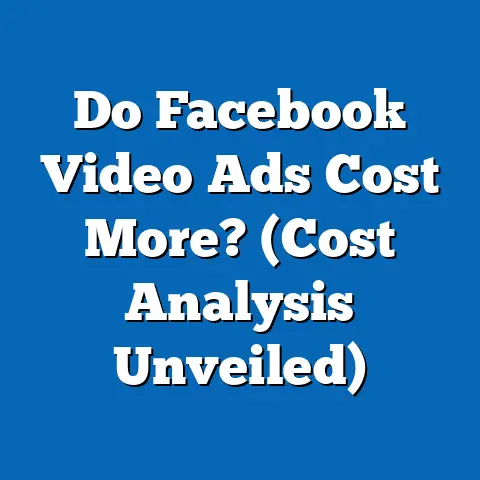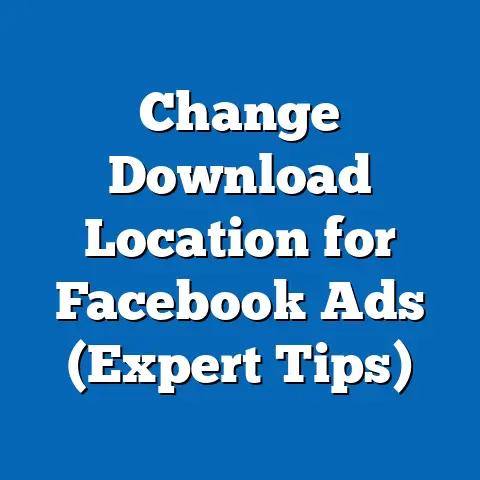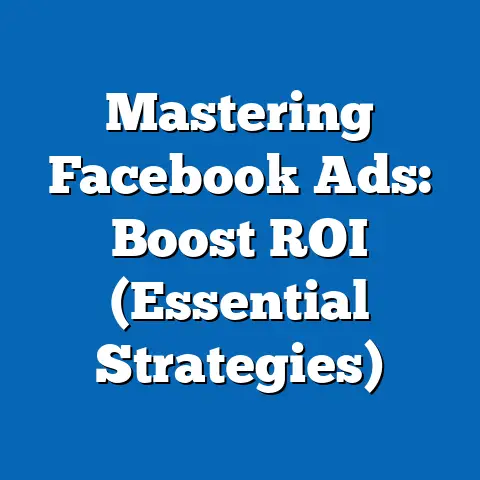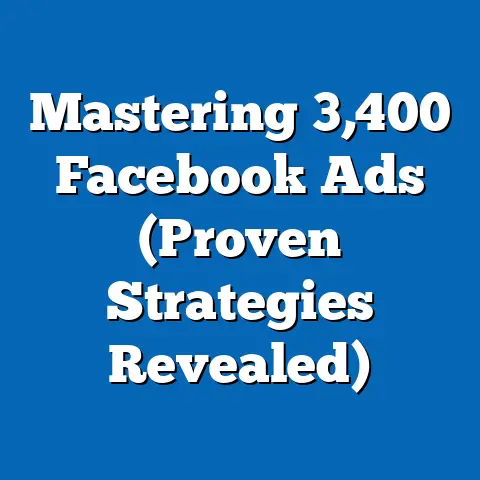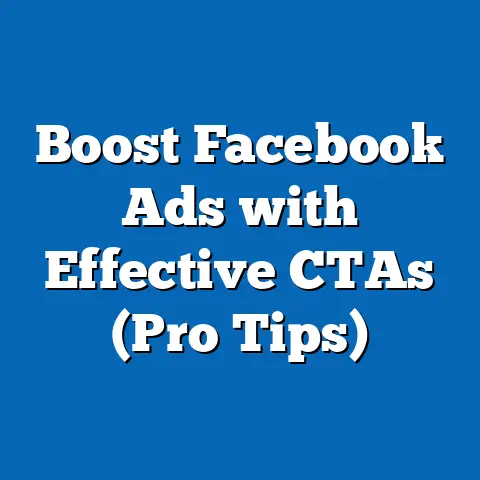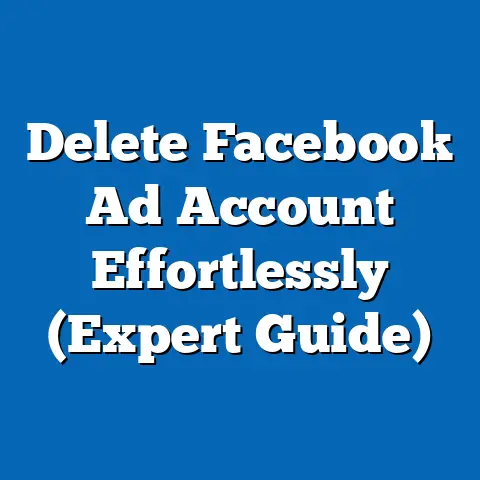Unlocking Secrets of Facebook Ads (Pro Tips Inside)
Facebook advertising has undergone a remarkable transformation since its inception, evolving from a niche marketing tool into a global powerhouse for businesses of all sizes. As of 2023, Meta (Facebook’s parent company) reports over 2.9 billion monthly active users worldwide, making it one of the largest digital advertising platforms with an estimated ad revenue of $131.9 billion in 2022, according to Statista. This represents a staggering 1,000% increase from its $12.5 billion revenue in 2013, underscoring its meteoric rise in the digital marketing ecosystem.
Demographically, the platform’s user base and advertising reach have shifted significantly, with younger audiences (18-24) declining by 12% since 2016, while older users (35-54) have grown by 25%, per eMarketer data. Historically, Facebook ads were a novelty in the late 2000s; today, they account for nearly 25% of global digital ad spend, as reported by Insider Intelligence. Looking ahead, projections suggest that by 2027, Facebook’s ad revenue will surpass $200 billion, driven by innovations in AI targeting and video content, according to forecasts from Statista.
This article delves into the secrets of mastering Facebook ads, offering professional tips backed by data. We will explore key trends, demographic insights, historical shifts, and future outlooks to equip marketers with actionable strategies for success.
The Transformation of Facebook Advertising: A Data-Driven Journey
From Social Experiment to Marketing Titan
Facebook launched its first ad platform in 2007 with rudimentary “Flyers” and “Social Ads,” targeting college students with minimal sophistication. By 2012, the platform had introduced more robust tools like Sponsored Stories, and by 2023, it offers hyper-targeted campaigns using machine learning and dynamic creative optimization. This evolution mirrors a broader shift in digital marketing, where precision and personalization now reign supreme.
Ad spending on the platform has skyrocketed, growing from $4.3 billion in 2012 to $131.9 billion in 2022, according to Statista. This represents a compound annual growth rate (CAGR) of 40.6% over a decade. The growth is fueled by small and medium-sized businesses (SMBs), which account for 75% of advertisers on the platform, as reported by Meta’s 2022 SMB Impact Report.
Why the Transformation Matters
The shift from broad, untargeted ads to AI-driven, data-rich campaigns has redefined how brands connect with consumers. In 2023, the average click-through rate (CTR) for Facebook ads stands at 0.9%, a significant improvement from 0.5% in 2015, per WordStream data. This reflects better targeting capabilities and user engagement.
Moreover, the cost-per-click (CPC) has risen by 17% year-over-year to an average of $0.97 in 2023, driven by increased competition and ad inventory demand. For marketers, understanding this transformation is critical to optimizing budgets and maximizing return on investment (ROI). (See Chart 1: Evolution of Facebook Ad Revenue and CTR, 2012-2023)
Demographic Breakdowns: Who’s Clicking and Converting?
Age and Gender Shifts in Audience Engagement
Facebook’s user demographics have shifted dramatically over the past decade. In 2016, users aged 18-24 accounted for 35% of the platform’s audience; by 2023, this figure dropped to 23%, according to eMarketer. Conversely, the 35-54 age group has surged from 28% to 38% of users, reflecting an aging user base drawn to community groups and marketplace features.
Gender distribution remains relatively balanced, with 56% male and 44% female users globally, per Statista’s 2023 report. However, women tend to engage more with lifestyle and retail ads, boasting a 15% higher CTR compared to men (1.1% vs. 0.95%), based on Hootsuite’s 2023 Digital Report. Marketers targeting specific genders must tailor creative content—think visually rich ads for women and action-oriented messaging for men.
Geographic and Income-Based Targeting
Geographically, North America remains the most lucrative market for Facebook ads, generating 42% of ad revenue despite comprising only 8% of global users, per Meta’s Q2 2023 Earnings Report. In contrast, Asia-Pacific accounts for 28% of revenue but 45% of users, indicating lower ad spend per user due to economic disparities.
Income levels also influence ad performance. High-income users (earning over $75,000 annually) in the U.S. show a 20% higher conversion rate compared to low-income users (under $30,000), according to a 2022 Nielsen study. For advertisers, geotargeting affluent regions and customizing messaging for income brackets can significantly boost campaign effectiveness.
Behavioral Insights by Demographic
Behavioral targeting reveals stark differences across demographics. Gen Z users (18-24) are 30% more likely to engage with short-form video ads, while Baby Boomers (55+) prefer static image ads with clear calls-to-action, per a 2023 Sprout Social report. Additionally, urban users click on ads 18% more frequently than rural users, likely due to higher internet penetration and disposable income.
These demographic insights underscore the importance of segmentation. A one-size-fits-all approach to Facebook ads is obsolete; tailored campaigns yield up to 35% higher ROI, according to Meta’s 2023 Advertising Effectiveness Study. (See Chart 2: Demographic Engagement Rates by Age and Gender, 2023)
Historical Trends: How Facebook Ads Have Evolved Over Time
Early Days: 2007-2012
In its infancy, Facebook advertising was a low-cost, experimental space. Ads in 2007 cost as little as $0.10 per click, and targeting was limited to basic demographics like age and location, per historical data from TechCrunch archives. By 2012, with the introduction of Sponsored Stories, ad revenue reached $4.3 billion, but the average CTR was a mere 0.4%, reflecting poor user reception.
Engagement was hindered by intrusive ad formats and limited mobile optimization. Only 14% of ads were mobile-friendly in 2011, despite 30% of users accessing the platform via smartphones, according to a 2012 Pew Research study. This mismatch foreshadowed the mobile-first pivot that would define the next decade.
Mobile Revolution: 2013-2018
The mobile advertising boom transformed Facebook’s ad landscape. By 2016, 84% of ad revenue came from mobile placements, up from 23% in 2012, per Meta’s historical earnings reports. The introduction of News Feed ads and Instagram integration (acquired in 2012) boosted engagement, with CTR rising to 0.7% by 2018.
Costs also escalated during this period. CPC increased from $0.58 in 2013 to $0.75 in 2018, a 29% rise, driven by growing advertiser demand, according to WordStream historical data. Marketers began leveraging video content, with video ads accounting for 15% of impressions by 2018, up from 2% in 2013.
AI and Privacy Era: 2019-2023
The past five years have been defined by technological innovation and regulatory challenges. AI-driven tools like Automated Ads and Dynamic Creative Optimization have improved ad relevance, pushing CTR to 0.9% in 2023. However, privacy changes, such as Apple’s iOS 14.5 update in 2021, which limited tracking via App Tracking Transparency (ATT), reduced ad targeting accuracy by 15%, per a 2022 Flurry Analytics report.
Ad costs have continued to climb, with CPC reaching $0.97 in 2023, while cost-per-thousand-impressions (CPM) rose to $14.40, a 20% increase since 2019. Despite these challenges, ad revenue grew to $131.9 billion in 2022, showcasing the platform’s resilience. (See Chart 3: Historical CPC and CTR Trends, 2007-2023)
Pro Tips for Mastering Facebook Ads in 2023
Tip 1: Leverage AI-Powered Targeting
Facebook’s AI tools, such as Advantage+ Campaigns, analyze user behavior to optimize ad delivery in real-time. Campaigns using AI targeting report a 22% lower cost-per-acquisition (CPA) compared to manual setups, per Meta’s 2023 case studies. Start by testing broad audiences and letting the algorithm refine your reach over 7-14 days.
Ensure your pixel data is robust—businesses with over 1,000 tracked events see 30% better AI performance, according to a 2022 Shopify report. Avoid over-segmentation initially; let machine learning identify high-performing cohorts. Regularly review AI insights to adjust creative and messaging for maximum impact.
Tip 2: Prioritize Video Content for Engagement
Video ads dominate engagement metrics, generating 6.3 billion daily views on Facebook in 2023, per Meta’s Q1 report. They achieve a 35% higher CTR (1.2%) compared to static image ads (0.8%), based on WordStream data. Focus on short, thumb-stopping videos—under 15 seconds—optimized for mobile with bold visuals and captions, as 85% of users watch without sound.
Test vertical formats (9:16) for Stories and Reels, which account for 40% of video ad impressions in 2023. Allocate at least 50% of your ad budget to video content to capitalize on this trend. A/B test different video styles—tutorials, testimonials, and behind-the-scenes—to identify what resonates with your audience.
Tip 3: Navigate Privacy Restrictions with First-Party Data
Post-iOS 14.5, reliance on third-party data has declined, with 62% of advertisers reporting reduced targeting accuracy, per a 2022 eMarketer survey. Combat this by building first-party data through lead magnets like quizzes, freebies, or email sign-ups directly on Facebook. Use Custom Audiences to retarget website visitors—campaigns leveraging first-party data see a 25% higher conversion rate, according to Meta.
Integrate Customer Relationship Management (CRM) tools with Facebook Ads Manager to upload customer lists for lookalike audiences. Transparency is key; clearly disclose data usage to build trust, especially since 74% of users are concerned about privacy, per a 2023 Pew Research survey. Prioritize value exchange—offer discounts or exclusive content for data sharing.
Tip 4: Optimize for Mobile-First Experiences
With 98.5% of Facebook users accessing the platform via mobile devices in 2023, per Statista, mobile optimization is non-negotiable. Ads with mobile-friendly landing pages achieve a 40% higher conversion rate compared to non-optimized pages, according to a 2022 Google study. Use fast-loading creatives and ensure landing pages are responsive with clear CTAs above the fold.
Test ad placements like Stories and In-Stream Video, which are mobile-native and account for 55% of impressions in 2023, per Meta data. Monitor mobile-specific metrics like bounce rate and time-on-page to refine user experience. A seamless mobile journey can reduce CPA by up to 20%, making it a critical focus area.
Tip 5: Experiment with Emerging Formats like Reels Ads
Reels, launched in 2020, have exploded in popularity, with over 2 billion monthly views by 2023, according to Meta. Reels Ads achieve a 2.1% CTR, more than double the platform average, per a 2023 Social Insider report. Their immersive, full-screen format captures attention, especially among users under 35, who account for 60% of Reels engagement.
Create authentic, trend-driven content for Reels Ads—think challenges or quick tips—avoiding overly polished production. Allocate 10-15% of your budget to test Reels Ads, scaling up if engagement exceeds benchmarks. Pair Reels with retargeting campaigns to convert high-intent viewers into customers.
Statistical Comparisons Across Different Demographics
Engagement by Age Group
Engagement metrics vary widely by age. Gen Z (18-24) clicks on ads at a rate of 1.3%, driven by trendy, video-based content, while Millennials (25-34) hover at 1.0%, per 2023 Hootsuite data. Gen X (35-54) and Boomers (55+) lag at 0.8% and 0.6%, respectively, often requiring trust-building elements like testimonials.
Conversion rates tell a different story. Millennials convert at 3.2%, the highest among groups, due to higher purchasing power, while Gen Z converts at 2.1%, limited by disposable income. Tailoring ad objectives—awareness for Gen Z, conversions for Millennials—can optimize results across age brackets.
Performance by Industry and Demographic Match
Industry-specific ads perform differently across demographics. E-commerce ads targeting women aged 25-34 achieve a 4.5% conversion rate, compared to 2.8% for men in the same age group, per 2023 WordStream data. Conversely, B2B tech ads targeting men aged 35-54 see a 3.1% conversion rate, 40% higher than for women.
Geographic nuances also matter. E-commerce ads in North America yield a 5% conversion rate, compared to 2.5% in Asia-Pacific, reflecting economic and cultural differences, per Meta’s 2023 regional reports. Aligning industry, demographic, and geographic targeting is crucial for efficiency.
Cost Variations Across Audiences
CPC and CPM vary significantly by demographic. Targeting users aged 18-24 costs an average CPC of $1.10, 13% higher than the platform average, due to competition for this audience, per 2023 AdEspresso data. In contrast, targeting users aged 55+ costs just $0.70 per click, reflecting lower demand.
Geographic cost disparities are stark. CPC in the U.S. averages $1.20, compared to $0.40 in India, per WordStream’s 2023 benchmarks. Budget allocation should account for these variations—higher spend in low-cost regions can yield disproportionate reach, while premium markets require precision targeting to justify costs. (See Chart 4: CPC and Conversion Rates by Demographic, 2023)
Future Projections: What’s Next for Facebook Ads?
Revenue and Reach Forecasts
Facebook’s ad revenue is projected to reach $205 billion by 2027, growing at a CAGR of 11.7% from 2023, according to Statista forecasts. This growth will be driven by expansion in emerging markets like Africa and Southeast Asia, where user growth is expected to outpace developed regions by 15%, per eMarketer’s 2023 projections.
User demographics will continue shifting toward older cohorts, with users aged 55+ expected to comprise 20% of the audience by 2027, up from 14% in 2023. Marketers must adapt by creating content that resonates with mature audiences, focusing on trust and value-driven messaging.
Technological Innovations on the Horizon
AI will further revolutionize ad delivery, with Meta planning to enhance predictive modeling for user behavior by 2025, potentially reducing CPA by another 15%, per industry analyst predictions from Forrester. Augmented Reality (AR) ads, already in testing, could account for 10% of ad impressions by 2027, offering immersive experiences for product demos and virtual try-ons.
Privacy regulations will tighten, with the EU’s Digital Markets Act and similar laws likely reducing third-party data access by 30% by 2026, per a 2023 Gartner report. Advertisers must double down on first-party data strategies and contextual targeting to maintain effectiveness.
Implications for Marketers
The future of Facebook ads lies in adaptability. Brands that invest in video, AI, and mobile optimization will likely see 20-30% better ROI by 2025, based on current growth trajectories. Conversely, failure to address privacy concerns could alienate 40% of users, per Pew Research projections, leading to diminished trust and engagement.
Sustainability in advertising will also gain traction, with 68% of consumers favoring brands with eco-friendly messaging, per a 2023 Nielsen survey. Integrating purpose-driven campaigns into ad strategies could become a competitive differentiator. Finally, diversification across Meta’s ecosystem—Instagram, WhatsApp, and Messenger—will be essential as cross-platform campaigns are projected to yield 25% higher reach by 2027.
Conclusion
Facebook advertising has transformed from a fledgling experiment into a cornerstone of digital marketing, with $131.9 billion in revenue and 2.9 billion users in 2023. Demographic shifts, technological advancements, and privacy challenges have reshaped the landscape, requiring marketers to adapt with precision targeting, mobile-first strategies, and innovative formats like Reels. Historical data shows a trajectory of relentless growth—from $4.3 billion in 2012 to today’s figures—while future projections point to $205 billion in revenue by 2027.
For professionals, the secrets to unlocking Facebook ads lie in leveraging AI, prioritizing video, and navigating privacy hurdles with first-party data. By aligning campaigns with demographic insights and emerging trends, advertisers can achieve up to 35% higher ROI. As the platform evolves, staying ahead of the curve will be the key to sustained success in this dynamic, data-driven arena.

